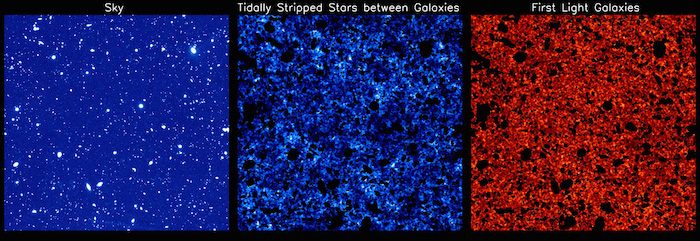.

The three panels show different components of near-infrared background light detected by the Hubble Space Telescope in deep-sky surveys. The one on the left is a mosaic of images taken over a 10-year period. When all the stars and galaxies are masked, the background signals can be isolated, as seen in the second and third panels. The middle one reveals “intrahalo light” from rogue stars torn from their host galaxies, and the panel on the right captures the signature of the first galaxies formed in the universe. Ketron Mitchell-Wynne
.
Hubble Space Telescope data, new statistical method instrumental to research project
.
Irvine, Calif., Sept. 7, 2015 – Astronomers from the University of California, Irvine and Baltimore’s Space Telescope Science Institute have generated the most accurate statistical description yet of faint, early galaxies as they existed in the universe 500 million years after the Big Bang.
In a research paper published today in Nature Communications, the team describes its use of a new statistical method to analyze Hubble Space Telescope data captured during lengthy sky surveys. The method enabled the scientists to parse out signals from the noise in Hubble’s deep-sky images, providing the first estimate of the number of small, primordial galaxies in the early universe. The researchers concluded that there are close to 10 times more of these galaxies than were previously detected in deep Hubble surveys.
UCI Ph.D. student Ketron Mitchell-Wynne, lead author on the paper, said the time period under investigation is known as the “epoch of reionization.” Coming after the Big Bang and a few hundred million years in which a dark universe was dominated by photon-absorbing neutral hydrogen, the epoch of reionization was characterized by a phase transition of hydrogen gas due to the accelerated process of star and galaxy formation.
“It’s the furthest back you can study with the Hubble Space Telescope,” Mitchell-Wynne said. Hubble’s cameras utilize charge-coupled devices, high-quality electronic image sensors first used in astronomy that later were employed in professional video cameras. The team looked at data spanning optical and infrared wavelengths. Photons in the infrared spectrum come directly from stars and galaxies.
UCI cosmologist Asantha Cooray, research project lead, pointed to recent probes into extragalactic infrared background light by the California Institute of Technology’s CIBER instrument. “CIBER measured the infrared background at two wavelengths, 1.1 and 1.6 microns,” he said. These measurements led the CIBER group to confirm the existence of “intrahalo light” from stars distributed outside galaxies.
Cooray, professor of physics & astronomy, said: “We believe it’s true that there is intrahalo light, but we made a new discovery by looking at five infrared bands with Hubble. We sort of overlap with CIBER and then go into short optical wavelengths, and we see in addition to intrahalo light a new component – stars and galaxies that formed first in the universe.”
The deep-sky survey was part of a larger Hubble-based research project called the Cosmic Assembly Near-Infrared Deep Extragalactic Legacy Survey. “CANDELS was not initiated for this cause, but it turns out that the way the data were taken was favorable for what we wanted to do,” Mitchell-Wynne said. “From the CIBER analysis, we knew there would be a detection of intrahalo light in the infrared bands. We didn’t really know what to expect in the optical ones. With Hubble data, we saw a large drop in the amplitude of the signal between the two. With that spectra, we started to get a little more confident that we were seeing the earliest galaxies.”
“For this research, we had to look closely at what we call ‘empty pixels,’ the pixels between galaxies and stars,” Cooray said. “We can separate noise from the faint signal associated with first galaxies by looking at the variations in the intensity from one pixel to another. We pick out a statistical signal that says there is a population of faint objects. We do not see that signal in the optical [wavelengths], only in infrared. This is confirmation that the signal is from early times in the universe.”
He thinks these primordial galaxies were very different from the well-defined spiral and disc-shaped galaxies currently visible in the universe. They were more diffuse and populated by giant stars. Cooray noted that more observational proof for his team’s findings will be possible with the launch of the James Webb Space Telescope in 2018. “These galaxies are very faint,” he said, “so if we have a bigger telescope, like James Webb, we’ll be able to go very deep and see them individually.”
“This is a very exciting finding,” said Henry C. Ferguson, an astronomer at Baltimore’s Space Telescope Science Institute and co-principal investigator for CANDELS. “It’s the first time that we’ve been able to convincingly measure this subtle signature of early galaxies with Hubble, giving us a firmer handle on what to look for when the James Webb Space Telescope launches a few years from now.”
Another area of research Cooray hopes to pursue in the near future is investigating the same part of the sky in other bands, such as X-rays, using NASA’s Chandra X-ray Observatory. “Could there be X-ray emissions associated with this primordial stuff?” he said. “Theoretical astrophysicists have explained that the earliest stars collapsed really quickly because they were so massive. They didn’t go supernovae and disperse material; they’re actually believed to have collapsed into black holes. We would like to see if there are any X-ray emissions associated with such events.”
About the University of California, Irvine: Currently celebrating its 50th anniversary, UCI is the youngest member of the prestigious Association of American Universities. The campus has produced three Nobel laureates and is known for its academic achievement, premier research, innovation and anteater mascot. Led by Chancellor Howard Gillman, UCI has more than 30,000 students and offers 192 degree programs. It’s located in one of the world’s safest and most economically vibrant communities and is Orange County’s second-largest employer, contributing $4.8 billion annually to the local economy.
Quelle: UCI
4636 Views
